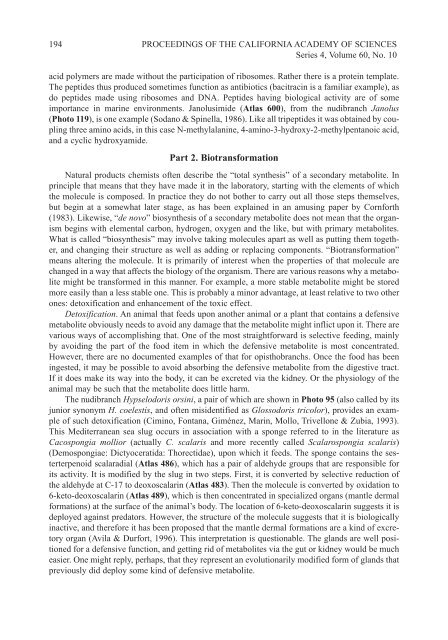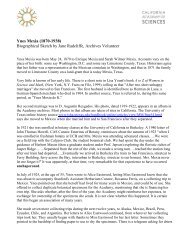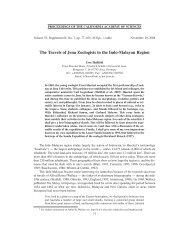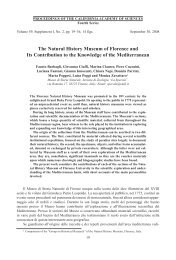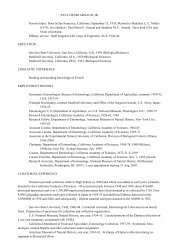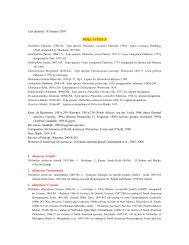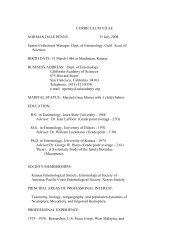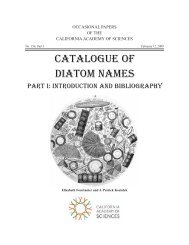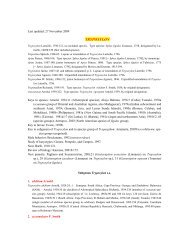Cimino&Ghiselin-tmpZXYZ:Template Proceedings_1.qxd.qxd
Cimino&Ghiselin-tmpZXYZ:Template Proceedings_1.qxd.qxd
Cimino&Ghiselin-tmpZXYZ:Template Proceedings_1.qxd.qxd
You also want an ePaper? Increase the reach of your titles
YUMPU automatically turns print PDFs into web optimized ePapers that Google loves.
194 PROCEEDINGS OF THE CALIFORNIA ACADEMY OF SCIENCES<br />
Series 4, Volume 60, No. 10<br />
acid polymers are made without the participation of ribosomes. Rather there is a protein template.<br />
The peptides thus produced sometimes function as antibiotics (bacitracin is a familiar example), as<br />
do peptides made using ribosomes and DNA. Peptides having biological activity are of some<br />
importance in marine environments. Janolusimide (Atlas 600), from the nudibranch Janolus<br />
(Photo 119), is one example (Sodano & Spinella, 1986). Like all tripeptides it was obtained by coupling<br />
three amino acids, in this case N-methylalanine, 4-amino-3-hydroxy-2-methylpentanoic acid,<br />
and a cyclic hydroxyamide.<br />
Part 2. Biotransformation<br />
Natural products chemists often describe the “total synthesis” of a secondary metabolite. In<br />
principle that means that they have made it in the laboratory, starting with the elements of which<br />
the molecule is composed. In practice they do not bother to carry out all those steps themselves,<br />
but begin at a somewhat later stage, as has been explained in an amusing paper by Cornforth<br />
(1983). Likewise, “de novo” biosynthesis of a secondary metabolite does not mean that the organism<br />
begins with elemental carbon, hydrogen, oxygen and the like, but with primary metabolites.<br />
What is called “biosynthesis” may involve taking molecules apart as well as putting them together,<br />
and changing their structure as well as adding or replacing components. “Biotransformation”<br />
means altering the molecule. It is primarily of interest when the properties of that molecule are<br />
changed in a way that affects the biology of the organism. There are various reasons why a metabolite<br />
might be transformed in this manner. For example, a more stable metabolite might be stored<br />
more easily than a less stable one. This is probably a minor advantage, at least relative to two other<br />
ones: detoxification and enhancement of the toxic effect.<br />
Detoxification. An animal that feeds upon another animal or a plant that contains a defensive<br />
metabolite obviously needs to avoid any damage that the metabolite might inflict upon it. There are<br />
various ways of accomplishing that. One of the most straightforward is selective feeding, mainly<br />
by avoiding the part of the food item in which the defensive metabolite is most concentrated.<br />
However, there are no documented examples of that for opisthobranchs. Once the food has been<br />
ingested, it may be possible to avoid absorbing the defensive metabolite from the digestive tract.<br />
If it does make its way into the body, it can be excreted via the kidney. Or the physiology of the<br />
animal may be such that the metabolite does little harm.<br />
The nudibranch Hypselodoris orsini, a pair of which are shown in Photo 95 (also called by its<br />
junior synonym H. coelestis, and often misidentified as Glossodoris tricolor), provides an example<br />
of such detoxification (Cimino, Fontana, Giménez, Marin, Mollo, Trivellone & Zubia, 1993).<br />
This Mediterranean sea slug occurs in association with a sponge referred to in the literature as<br />
Cacospongia mollior (actually C. scalaris and more recently called Scalarospongia scalaris)<br />
(Demospongiae: Dictyoceratida: Thorectidae), upon which it feeds. The sponge contains the sesterterpenoid<br />
scalaradial (Atlas 486), which has a pair of aldehyde groups that are responsible for<br />
its activity. It is modified by the slug in two steps. First, it is converted by selective reduction of<br />
the aldehyde at C-17 to deoxoscalarin (Atlas 483). Then the molecule is converted by oxidation to<br />
6-keto-deoxoscalarin (Atlas 489), which is then concentrated in specialized organs (mantle dermal<br />
formations) at the surface of the animal’s body. The location of 6-keto-deoxoscalarin suggests it is<br />
deployed against predators. However, the structure of the molecule suggests that it is biologically<br />
inactive, and therefore it has been proposed that the mantle dermal formations are a kind of excretory<br />
organ (Avila & Durfort, 1996). This interpretation is questionable. The glands are well positioned<br />
for a defensive function, and getting rid of metabolites via the gut or kidney would be much<br />
easier. One might reply, perhaps, that they represent an evolutionarily modified form of glands that<br />
previously did deploy some kind of defensive metabolite.


